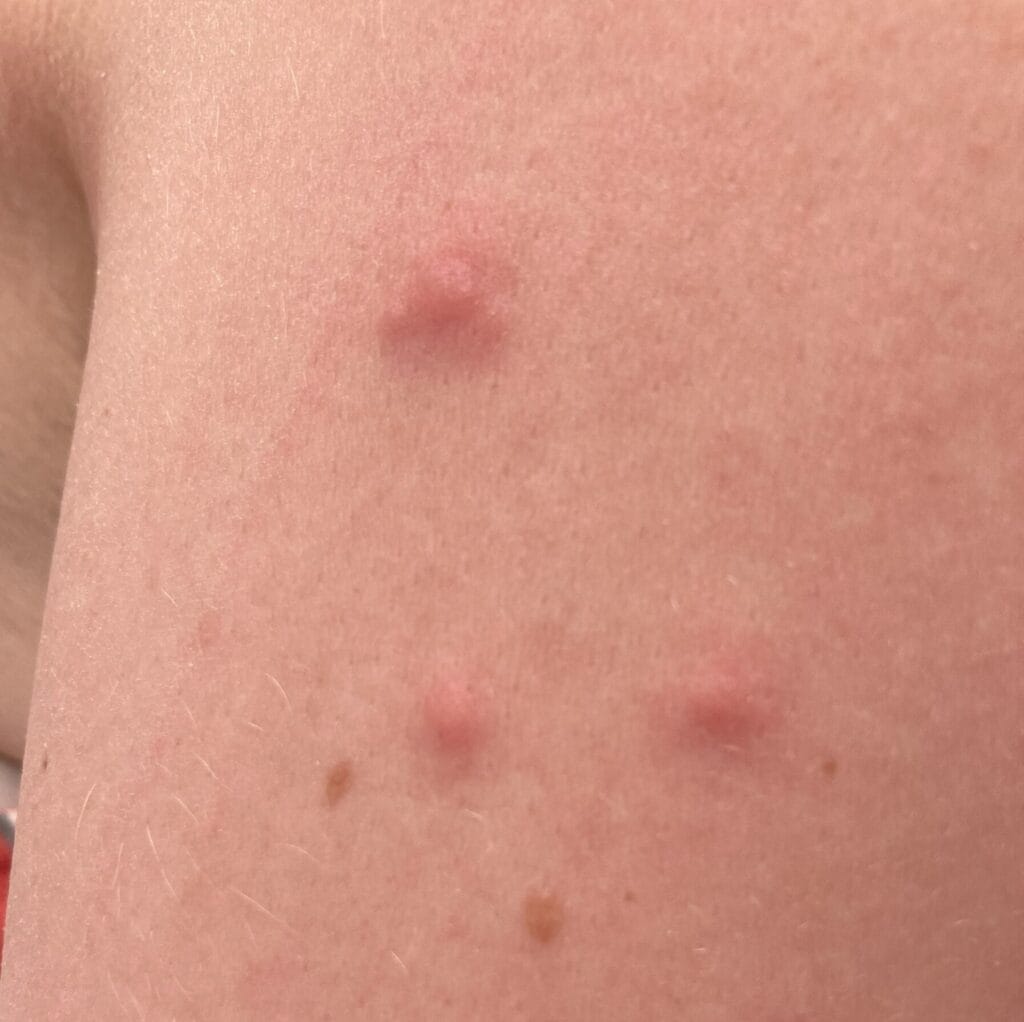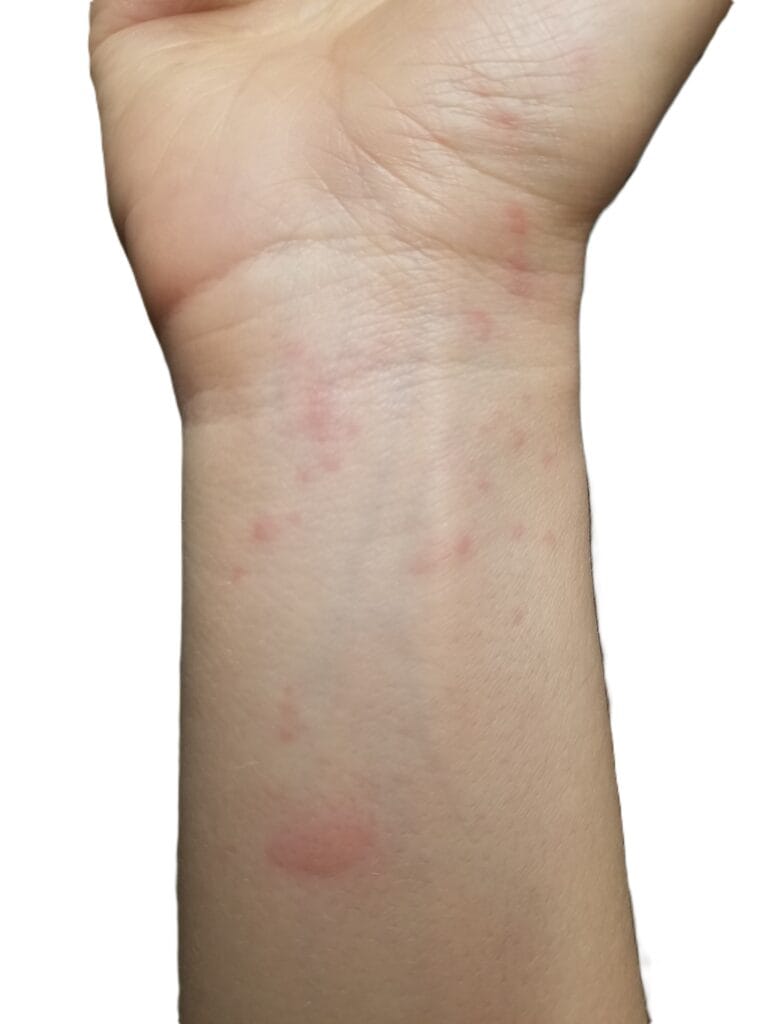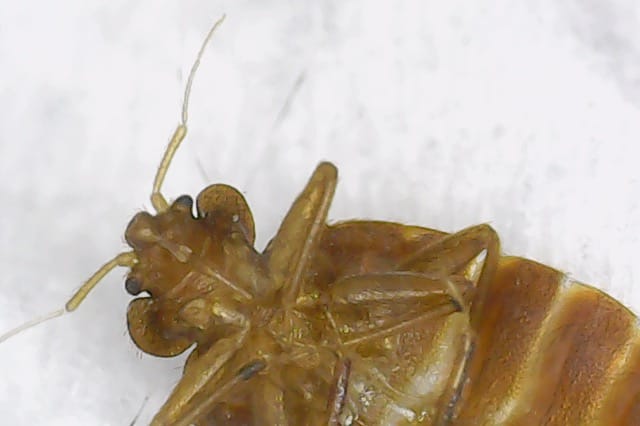Unusual Bites from Bed Bugs or Something Else?
You woke up with mysterious bite marks. Could they be from bed bugs? As someone who has had bed bugs twice, I can help you determine the cause with pictures of real bites from bed bugs and other common culprits.
DISCLAIMER: I am not a doctor. The medical/health information provided is for general information and educational purposes only, and it is not a substitute for professional advice. Before taking any action based on this information, always consult with appropriate professionals.
Identifying Bites
While bite marks can be a sign of bed bugs, they are not a reliable indicator. It’s possible to have bed bugs without seeing visible bites. If you do have bites, they could be caused by a number of things from insects to mites like scabies or chiggers (Fésűs et al., 2021) Additionally, what may look like bites could actually be a sign of a medical condition (Goddard & deShazo, 2009).
So what do bed bug bites look like?
Bed bug bite reactions vary from person to person . Mine were small, raised red dots, but a friend of mine had much larger, puffier bites without any color, more like mosquito bites. And as I mentioned, some people don’t develop any marks at all. That’s not to say they’re not being bitten—it just means their bodies react differently to the bites (Goddard & deShazo, 2009).
Here’s what my real bed bug bites looked like:


Don’t be fooled by imposters!
When I caught bed bugs the first time, I developed additional red spots which I assumed were more bites. Turns out they were hives. So I continued believing that I still had bed bugs long after they were gone. To further support my delusion, the hives would flare up in the morning due to histamine levels peaking at that time.
The kicker? Bites as well as psychological stress from bed bugs can cause hives (Gerasimos Konstantinou & George Konstantinou, 2020; Scarupa & Economides, 2006). In my case it was likely both. This is why I emphasize that bites are not a reliable indicator.—don’t treat for bed bugs unless you actually see them.
And yes, the hives eventually went away! But here’s what they looked like:


Inspecting for Bed Bugs
If you have bite marks but have yet to see any bed bugs, there are a few ways to check for them.
Professional Inspections
Some pest control companies offer free inspections, though you may have to pay a small trip fee. Keep in mind that bed bugs are excellent at hiding, so even professionals can miss them. In fact, self-proclaimed “experts” couldn’t find anything during their first visit to my home. It wasn’t until I collected a bed bug myself that they believed me.
You can also hire a bed bug-sniffing dog, but this method can be pricey, with costs starting around $250. Furthermore, research has shown that detection dogs are not always reliable. In this study, Cooper et al. (2014) found that scent dogs falsely detected bed bugs 15% of the time and correctly detected them only 44% of the time. Doesn’t seem worth the investment to me.
DIY Inspection
If you prefer not to pay for “professional” help, you can inspect your home yourself. Check around your bed, headboard, and baseboards. Pay special attention to cracks, crevices, and folds, as bed bugs often hide in these areas. Look not only for the bed bugs themselves, but also their eggs, excrement, and shed skins. Plain white bedding is ideal for spotting them more easily.
Here’s an example of what you might find between your mattress and box spring if you have a bed bug infestation:

Disclosure: As an Amazon Associate, I earn from qualifying purchases.
If your initial inspection doesn’t turn up anything, try moving your bed away from the wall and placing interceptors (paid link) on the legs. If your bed has larger legs like mine, these XL interceptors (paid link) might be a better fit. Research shows that interceptors are much more effective than visual inspections (Wang et al., 2009). These devices trap bed bugs as they attempt to reach you while you sleep, and they can be used to both monitor and control an infestation.
Note that the aforementioned study used interceptors dusted with talcum powder to make the insides more slippery and harder for bed bugs to climb out. Just be careful—baby powder now contains cornstarch, not talcum powder (paid link), and cornstarch may reduce the interceptors’ effectiveness. Also, breathing in powder can be harmful, so take precautions.
Identifying Bed Bugs
If you find bugs, how can you be sure they’re bed bugs? Bed bugs can look different depending on their life stage and whether they’ve recently fed. Adult bed bugs range in color from dark to reddish brown and are about the size of an apple seed. Their eggs are more difficult to spot because they are much smaller, closely resembling grains of rice.
Real photos of my bed bugs:



Below are a couple bugs commonly mistaken for bed bugs: carpet beetle larvae (left) and baby cockroaches (right). Even I had to pull out a magnifying glass when I encountered these critters just to be sure.


Other imposters include bat bugs which are nearly identical to bed bugs but far less common. Even their names are strikingly similar! So when I found bed bugs the second time, I decided to look closely before panicking.
To tell them apart, look at the length of their hair. Bed bug hairs are shorter than the width of their eyes, while bat bug hairs are longer. To get a closer look, I used Cainda’s digital microscope camera (paid link).

Real photo taken with Cainda’s digital microscope camera (paid link):

As you can see, its hairs are shorter than the width of its eyes. Panic-mode activated.
What Next?
So you’ve discovered bed bugs—what now? For tips on treating bed bugs naturally, check out this blog: How to Kill Bed Bugs with Essential Oils. Just remember, effectively treating bed bugs requires a comprehensive approach which we’ll cover more in future posts. Be sure to visit and bookmark helpwithbedbugs.com for my latest updates. You can also leave a comment with any questions or suggestions.
Until next time, I’ll be praying for you! xD


